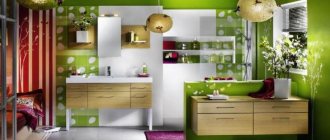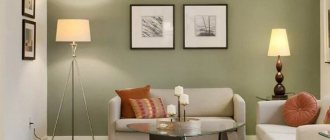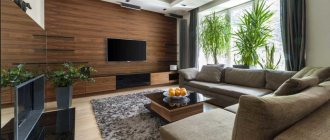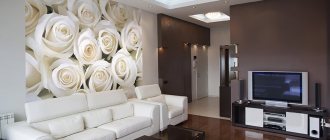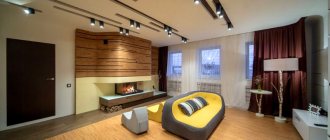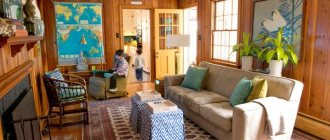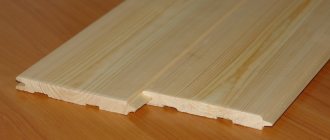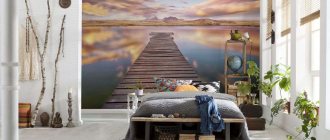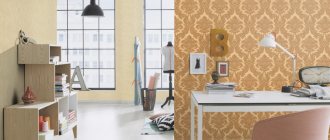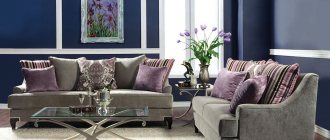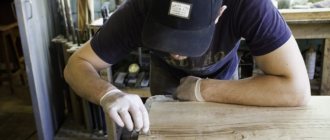Among the variety of wall finishing methods, decorative plaster travertine is incredibly popular. This material is practical, aesthetic and durable. With it, craftsmen create a coating that imitates the texture of natural stone and give it a variety of effects. With the help of tints, waxes, and paints, plaster is painted in any color. To decorate the room, it is better to hire an experienced craftsman, but if you have the skills, you can make travertine from putty yourself.
Properties of travertine
Travertine is something between limestone and marble, or rather, it is an intermediate form of converting one into the other. The stone, also called calcareous tuff, has a slight hardness. Color ranges from white to yellow and gray with characteristic veins. Much less common are stones of reddish, brown and nut hues.
A lot of travertine lies in Italy, not far from Rome, where the most majestic structure made from this stone was built. There are also deposits in Turkey, Armenia, Germany, Azerbaijan, Kyrgyzstan and Tajikistan. In Russia, travertine is mined in Kamchatka, in the Pyatigorsk region, and also in the Leningrad region.
Wild travertine, as a rule, is not used - the stone is ground and polished, which makes it possible to obtain a more interesting surface. In addition, treated travertine is stronger than wild travertine.
According to the processing method, travertine can be:
- polished – characterized by slight roughness;
- polished - a surface with a characteristic shine, the structure of the stone is best visible;
- brushed - stone processed with special brushes, thanks to which the surface becomes slightly rough and takes on an aged appearance;
- polished - a stone with a smooth surface, unlike polished - lack of shine;
- sawn – a stone with a noticeable relief;
- bush hammered - a stone with a well-defined texture, this is usually used to decorate the facade.
Polished travertine
Travertine is widely used in decoration, and all because of its many advantages :
- chic appearance of processed stone, availability of different shades and processing methods;
- versatility;
- durability;
- resistance to moisture, frost and temperature changes;
- ease of processing;
- good heat and sound insulation qualities;
- relatively high strength;
- lighter weight compared to many other natural stones;
- possibility of restoration.
Travertine is cheaper than many natural stones, but has a loose structure, which is why it can easily absorb various substances. Stone is especially afraid of acid, so spilled orange juice or vinegar on the countertop should be wiped up immediately. Travertine does not have the same strength as granite, it is much softer and brittle and does not scratch glass, but polishing makes it stronger. If any individual tile in the finish is damaged, it can be easily replaced.
Sawn travertine
Travertine has been used by people for many centuries for various purposes. It’s easier to say what is NOT made from it than to list all possible products. Travertine is produced in tile format for cladding walls, floors and facades; it is used to create window sills, steps and countertops. All this and much more is offered by Newlita, which has been selling travertine stone since 2002 and delivers it directly from Italy, Armenia, Kyrgyzstan and Turkey. The company has its own travertine quarry and a factory where tiles of various formats, slabs are produced, and products from this stone are also created according to customer orders. The supplier is confident in the high quality of travertine and gives it a 100-year guarantee.
Advantages, disadvantages and properties of plaster
It is worth mentioning that travertine decorative plaster is odorless, non-toxic and non-flammable. So, plaster has a very fine fraction (crumbs), and therefore it is easy to hide scratches, chips, cracks, etc. The material is applied in a thick layer, and therefore it can be used to correct all surface irregularities. The material has a wide range of colors and shades, but it is worth remembering that after drying the plaster becomes a tone, or even 2 lighter, so you need to initially choose the right color and tone.
Advantages of decorative travertine plaster
The main advantages of the material:
- Easy to apply
- Environmentally friendly material
- Vapor permeability
- Inexpensive cost
- Strength
- Masking imperfections in walls and other surfaces
- Unique drawing
- Easy to care for
- Wide range of colors
- Resistance to water, moisture, fire, biological factors
As for the disadvantages, these are some difficulties in professional application of the material. But this can hardly be called a disadvantage, since everything comes with experience. We recommend purchasing this product. With the help of travertine, a unique style is created, and all this can be done with your own hands; even a beginner without special training can do it. And because of the cost-effectiveness of use, this can be done for little money. And the end result itself will pleasantly surprise you. And the long service life, resistance to physical factors and ease of use will also not leave anyone indifferent.
No. 1. Travertine for facade
For cladding facades, travertine slabs ranging in size from 30*30 cm to 60*120 cm are used. Slabs - large slabs up to 2*3 m in size, which make it possible to make cladding with a minimum number of seams. A house completely decorated with such material will look very chic, but an equally elegant effect can be achieved if only the basement part of the facade is covered with travertine. The stone harmonizes perfectly with the plaster, so for a relatively small amount you can get a chic and sophisticated façade.
Travertine is not afraid of moisture and frost, it is lighter than marble, and has record durability, so investing in such a material is completely justified. Moreover, over time the stone changes slightly, but this does not spoil it. We can say that travertine is getting old.
You can also use other travertine elements in the decoration, for example, pilasters, balusters and other products in order to make the facade unique. All this can be supplemented with steps and railings made of the same stone, but you can successfully combine it with cheaper materials, for example, tiles, porcelain stoneware, clinker bricks. A facade made of travertine of different shades will look no less interesting. Let the main part be made of a light stone, and one or more stripes be made of a slightly darker stone.
Installation of a travertine facade is carried out in one of the following ways:
- wet method , when the stone is mounted on a pre-insulated wall using an adhesive mixture. To make the structure more durable, a reinforced layer is used and the slabs are additionally secured with metal clamps. Installation can only be carried out at a temperature of +10…+150С;
- The ventilated facade method involves attaching travertine to a pre-equipped metal frame, i.e. An air gap is created between the facade itself and the finishing, which increases the thermal insulation of the house. If necessary, you can use thermal insulation material, then you will be able to achieve the highest results in terms of heat conservation.
This façade will not require any maintenance. Thanks to the processing of the material, the porosity of its outer surface is reduced, so it will not absorb dirt, however, after many years of use, the facade can be washed with a stream of water under high pressure.
Preparation for plastering work
Travertine plaster is available in two types: for external and internal use.
For interior work, the material is made from marble chips, quartz sand and lime. The basis for it is white cement with the addition of dyes. Finishing professionals do not recommend making travertine mixtures yourself, since it is quite difficult to obtain a good final result. It is better to use ready-made compounds: they are more expensive, but they will pay off in the process of application and operation.
To achieve an excellent result, in addition to the putty mixture, you should also prepare the necessary tools. Classic plasterer-painter tools are designed for this. For the puttying and plastering stage you will need:
- Spatulas, possibly of several types.
- Metal graters.
- Trowels.
For decoration (depending on the planned relief) you need sponges, rollers, bristle brushes or fishing line.
The final finish will be created by:
- Brush.
- Roller.
- Painting glove.
In addition to this list, it is advisable to prepare a construction mixer, a water sprayer, sandpaper and cotton rags may come in handy.
No. 2. Travertine for wall decoration
For interior decoration, stone is used in different processing methods - it all depends on the design idea. Note that polished travertine remains a universal solution; it looks great in both classic and modern interiors. The size of the tiles can be different: from fairly large samples (30*30 cm, 60*60 cm, 30*60 cm) to mosaics. Walls can also be faced with large slabs. In any case, the walls must be strong enough to withstand such a load.
Travertine tiles will look good in almost any room of the apartment:
- for bathroom this is almost an ideal option. The material is not afraid of moisture, hygienic and durable. For small bathrooms, it is better to choose tiles with shine - due to the play of light and glare, the room will seem a little larger. If you decorate all the walls and floor with travertine, you will create the effect of a light stone cave - very stylish and beautiful. You can combine stone with different types of surface: embossed, matte, polished;
- in the kitchen travertine can be used to finish the apron; both tiles and mosaics will look great. You can, of course, finish all the walls, or highlight one wall in the dining area - this is the case when any solution will look great. Travertine can be combined with ceramic tiles or plaster; it looks good with painted surfaces and frescoes in sand tones;
- part of the hallway walls can also be finished with travertine. Guests will understand from the threshold that they have entered the house of a wealthy person who does not like banal decisions;
- in the living room The main thing is not to overdo it with stone, so as not to end up with a too cold and uncomfortable room. You can lay out only one wall or part of it, for example, an area near a fireplace or TV;
- in the bedroom , but if you really want to, you can use it to lay out a niche or decorate the area above the head of the bed. The main thing is not to overdo it;
- Such pompous decoration looks best in the spacious halls of private houses and non-residential buildings. Travertine is used in the decoration of banks, important government institutions, restaurants, hotels, etc.
Since the stone is quite heavy, the main thing is to prepare the surface well. The wall must be strong and durable; it is advisable to secure a reinforcing mesh. Travertine is placed on a special glue (a regular cement-sand mixture may not withstand). It is better to secure each slab or slab using wire, under which a recess is created on the inside of the stone. To further protect the stone, after installation it can be coated with moisture-repellent and antifungal impregnation. Such manipulation will not affect the appearance of the finish.
Variety of textures and reliefs
Travertine plaster in the hallway
As for diversity, there are two application techniques:
- Continuous coating
- Partial coverage
In continuous coating, the method is to cover the entire surface evenly, but create gaps in the idea of pits (indentations) using different thicknesses of spatulas. And in partial coverage you need to randomly create bumps in different places on the surface. And these irregularities are created using a hard brush, sponge or rags. In both technologies, textured stone looks very natural. The effect is amazing. As for the drawing, it happens:
- Vertical
- Horizontal
- Mixed
- Spotted
No. 3. Floor finishing
Everything here is about the same as with wall decoration. Tiles are available in different sizes and with different surface treatments. If there is a source of water in the room (kitchen, bathroom), then it is better not to take the polished version - it is very easy to slip on such tiles. Do not be afraid that unpolished stone will absorb moisture - manufacturers treat the material with special adhesives that perfectly fill the pores of the product. It is better to take the most dense material possible, since there is an increased load on the floor.
Travertine is suitable for rooms such as hallway, kitchen, bathroom. In the living room it will look too cold and strict. Do not forget that tiles can be laid out not only in a strict order, like the cells in a school notebook, but also in a checkerboard pattern, diagonally, and whole patterns can be formed from products of different sizes. An interesting effect can be achieved by combining travertine of different shades and with different types of surface. You can also experiment by combining stone with other materials.
Classic technique of applying travertine plaster
In this case, classic means an ordered pattern with horizontal stripes (pierces). Don't think that this technique is elementary. Although the texture looks somewhat simple, it will require experience to execute. The performer of the work simply will not have the right to make a mistake, because applying travertine requires error-free and precise movements with the tool. It is important to catch the moment when the material begins to dry out and, using a Venetian trowel, begin to form the design. To do this, use the edge of the long side of the trowel to form holes on the surface of the coating, and then smooth them with force with the flat side of the tool. In this case, a sprayer with water is used to wet the surface of the coating (which is especially important when working with calcareous material). According to the classical technique, you need to rub the relief in one direction, but, in general, this is not necessary: it all depends on what kind of pattern you want to get in the end.
No. 4. Travertine countertop
Travertine countertops are made for bathrooms and kitchens. As a rule, such things are made to order. Their ability to fit into both classic and modern interiors once again speaks to the versatility of the material.
Travertine can be used to create a monolithic countertop that is quite large in area, and this is a big plus when it comes to a surface that is constantly exposed to moisture and grease. A kitchen sink or bathroom sink can be made of metal or porcelain - the materials combine well. The option with a travertine sink will cost a little more. In this case, the countertop and sink will be a single structure without seams - beautiful and practical.
Polished and unpolished stone are not afraid of moisture, but they remain weakly resistant to acids, so you will have to work carefully on such a countertop. If you spill vinegar, juice or champagne, it is better to immediately wipe up the puddle. A stone with a rough matte surface “collects” dust better than a smooth one, so it will require more careful care.
Travertine is also used as countertops for bar counters, dining tables and kitchen islands. If the budget allows, then all horizontal surfaces in the kitchen can be made of this stone.
Application technology
The imitation can be similar to polished or untreated stone, or a stone wall made of blocks. For each of these cases, travertine plasters and types of application of the compositions vary. The imitation of massive polished stone is performed using the Venetian plaster technique. Below are other application methods.
Continuous application
When creating Traventino, the decorative layer can be applied in different ways. In general, the application of such plaster is very similar to the technology of plaster called the world map.
The three most common methods:
- The prepared solution is applied with a trowel or spatula in an even layer up to 2 mm. Then the coating is treated with a hard brush or a wide brush, which imitates a porous surface. Porous areas at this stage can account for up to 80% of the area. These percentages will decrease after smoothing the plaster layer.
- The solution is transferred to the wall with the end of a hard brush using poking movements. The relief surface of the stone is created immediately. This method is somewhat more laborious and slower.
- The stone surface is imitated by trimming the applied mortar with the working surface of a trowel, on which the mixture is distributed with a spatula. The touch-free method creates the required surface roughness.
After 15-20 minutes, the surface of the layer is slightly smoothed with a clean, damp trowel. This is done so that smooth areas are mixed with rough ones. The direction of movement of the trowel should be multidirectional.
Partial application
There is a way in which decorative plaster with a travertine effect may not be completely applied.
The work sequence is as follows:
- contact primer with quartz filling is applied tightly (without gaps) onto the prepared wall with a roller. It is even better if two layers are applied, since in this case the soil will not completely overlap on top. If the coating is planned to be two-color, then the primer can be tinted.
- The working composition is applied to the dried soil. This is done with a trowel using the trimming method. A small amount of the mixture is applied to the trowel with a spatula and evenly distributed, which is transferred to the wall using a “touch” technique in places (not over the entire surface). After drying begins, the mixture is smoothed and redistributed in different directions with the edge of the trowel. The trowel is held at an angle of up to 30 degrees to the wall.
- After the coating has dried, the wall is cleaned of flaws with sandpaper or using mechanical means.
Horizontal drawing
The drawing is made with a spatula “to tear through”.
Subsequence:
- A base thin, even layer is applied to a dried, primed surface. After drying, a decorative layer with an area of approximately 2 sq.m. is applied to the thickness of the grains with a trowel. Allow the layer to dry so that the solution does not stick to your fingers. A level is applied horizontally to the wall. A spatula blade positioned perpendicular to the wall is drawn along the layer along it. In this case, part of the mortar is removed from the wall. They try to make the tear stripes so that they look natural. The material removed with a spatula is thrown into a bucket. It is suitable for repeated application on the wall.
- While the treated area dries, apply the mixture to the next one. After a short break, the area with the holes is smoothed and compacted with a clean trowel along the holes. The next seal is done in the same way after 10-15 minutes. After which the layer is allowed to dry completely. Smoothing three times makes the wall smooth. No sanding required. In some places grains of sand remain on the surface. They are easily removed with a brush.
Vertical drawing
The drawing is applied similarly to the horizontal one, but in the direction from top to bottom (with a little experience, you can not use a ruler). You can also imitate travertine with decorative plaster by applying it diagonally.
Making masonry
For masonry or wall cladding, travertine is usually used in blocks or slabs. Travertine block masonry or cladding can be imitated by applying a grid of “joints” to the wall. The first method is to scratch lines using a chisel or other sharp object. A ruler is applied to the wall with a drying decorative layer, the surface of which has already been shaped like stone, and the seams are scratched along it. After this, the “seams” are smoothed a little with a damp, semi-dry brush to smooth out the burrs.
Formation of brickwork using the “scratching” method.
Another technique for simulating masonry, which uses decorative travertine plaster, is similar to imitation brickwork.
Sequence of work:
- Prepare the mixture, mix the finished mixture, combine the dry mixture with water.
- Apply evenly 1-1.5 mm. trowel or wide spatula.
- After 5-6 hours, mark the wall and stick it on, leaving tails and ribbons (first horizontal, then vertical on top of them).
- Stir the mixture with water until it drains. Apply a 2nd layer of 1-1.5mm using a hopper.
- After 15-30 minutes you need to smooth the layer with a wet trowel (after this you can additionally apply another layer of plaster for expressiveness, smooth it after the same period of time).
- Remove tape strips.
- At the moment of drying, smooth it with a trowel until glossy, or after 10-12 hours at an air temperature of +15 ° C (after the layer has completely dried), grind it with a grinder (abrasive from 150 to 500).
- Blow with compressor air to remove dust.
- Apply ProtectGuard STUCCO protective impregnation in 2 layers using the “wet on wet” method.
From this number of methods, anyone, even a novice finisher, can choose the one that suits him. A piece of drywall will serve as a place to test and practice applying the mixture.
No. 5. Travertine sink
A travertine sink harmonizes perfectly with the same countertop, but can be installed on a wooden countertop - this combination looks great in the interior of a classic bathroom. In addition, the countertop can be made of tiles, porcelain stoneware or natural stone, but of a different type. The ease of processing travertine allows you to create sinks of any shape from it.
Add grandeur to your front entrance with travertine floor tiles
If you want to add a luxurious aesthetic to your foyer, choose travertine. Known for its uneven or chiseled surface, travertine will look stunning in any home of any style. For this purpose, you can use both travertine mosaic tiles and large stones. This material is one of those few that can give a sophisticated look to your front entrance.
No. 6. Travertine window sill
Travertine is not afraid of direct sunlight and temperature changes, so it would be appropriate for organizing a window sill. It will look good both in the kitchen and in the bedroom, and due to the fact that travertine comes in different shades, you can always choose the most suitable option. Most often, window sills are made in a polished design, but if the interior requires it, you can also install a matte product.
This window sill looks harmonious with wooden windows. Plastic windows with a brown profile are also suitable, but in some cases ordinary white frames also look good.
Mixture consumption and popular manufacturers
The thickness of the applied plaster is small. Therefore, material consumption is usually small - on average only 1.5-2 kg/m2. The consumption of the mixture depends on the recipe, coating technique and level of skill. For an accurate calculation, you can use our online decorative plaster calculator.
Textured travertine mixtures, ready-made or in powder form, are produced by many manufacturers:
- Travertino (Russian manufacturer Wowcolor),
- Calce Antica a Spatola (Italian company J COLORS SpA),
- Travertinus (Italian producer Adicolor),
- Verona (Russian manufacturer),
- Decorazza Traverta (Russian holding Interra Deco Group),
- Marmo Antiko and Intonachino Minerale (Italian manufacturer San Marco),
- Traverto Sol (Russian company MascaradE),
- Jazz travertino (Italian manufacturer Colorifico Sammarinese),
- Travertino Clavel (French company Clavel),
- Roman stone (Russian company Optimist-elite), etc.
Do-it-yourself decorative plaster is not only a “bark beetle” or a “fur coat”, but also more complex imitations. Dress your home in Romano travertine and you will feel like you are at the crossroads of times and on the crest of progress.
No. 7. Travertine shower tray
If travertine has already been used in the decoration of the bathroom, then a shower tray made of the same material will look very appropriate. The shape of the product can be any. Manufacturers use rough stone to make pallets and additionally create a three-dimensional pattern on it to reduce the risk of falling.
You can also make a bathtub from stone, but such products are in very low demand.
Simple options for the decorative surface of travertine
The technique of applying decorative plaster is almost identical to working with other decors and, first of all, requires high-quality preparation of the surface for travertine. To do this, the wall is leveled with putty, cracks and irregularities are sealed. After cleaning, a proprietary composition, often called quartz primer, is applied to the surface of the old wall base.
If you decide to use a relatively simple decorative travertine pattern with a monotonous surface, you can use a layer of cheaper finishing or super-finishing putty as a primer, which becomes clearer in more detail from the video
Before applying the main layer of decor, the soil is carefully leveled and dried using a spatula and trowel, as in the photo. After obtaining the ideal sublayer, you can begin applying plaster. It is important to carefully level the layer before the liquid mixture has yet set and turned into a viscous and stubborn mass. From this point on, you can apply the relief of the coating and pattern itself, much like in the video
At the next stage, the drawing is smoothed with a spatula so that the main plane of the plaster decor looks like a cut of natural travertine stone, beautiful, as in the photo.
The simplest designs can be obtained on a wall surface plastered with decor by simple linear rubbing with a spatula.
The resulting cavities and sinks can be tinted using special dyes, after which the entire surface of the decor is covered with a protective composition based on water-soluble wax.
No. 9. Travertine staircase
Limestone is used to create indoor and outdoor staircases. Due to its unique texture, travertine is a bit reminiscent of wood, so these steps will fit perfectly into the classic style and will look appropriate even in a wooden house.
Since the stone is not afraid of frost and can withstand moisture, it can also be used to create external stairs. Only dirt can have a negative impact on such steps, so it is better if the stone has already been treated with special protective agents. Otherwise, you will have to independently treat the surface with impregnations.
Travertine steps harmonize perfectly with railings made of wood and forged metal. To make the front entrance look even more pompous and luxurious, handrails and balusters can be made from the same travertine.
What does it look like
Natural travertine has a porous structure, light yellow, beige, and sometimes gray-green color. It lends itself well to polishing and sanding. The porous texture of the stone is susceptible to precipitation and exhaust gases, so it is more often used as a finishing material for interior walls.
What real travertine looks like can be seen in the photo:
Textured plaster with a travertine effect very accurately replicates the color and texture of the stone. How it looks in the interior, look at the following photos:
Decorative plasters also include liquid travertine - an elastic mixture consisting of 90% ground natural stone and binders. This coating is often used on facades in combination with imitation block masonry, as well as columns and other elements of Roman (Romanesque) architecture, in which travertine was widespread. This is where the name travertino romano comes from.
No. 10. Travertine paving stones
Let us note right away that laying the local area and paths with travertine is quite expensive, but such a covering will also serve for a very long time. Patio areas paved with stone look beautiful. Travertine can also be used to decorate the area around the pool. For such purposes, it is better to take a stone with a rough surface and special impregnation so that dirt does not clog into the pores of the material. Of course, it is better not to finish the car area in this way.
If the adjacent territory of the mansion is large enough, and all of it (or part) is finished with travertine, then, if you have the funds, you can supplement it with a fountain made of the same stone. Usually such fountains decorate central city parks, but if you have the funds, then something similar can be implemented on your own site.
How to care for and impregnate travertine?
Natural travertine is easy to clean . To care for it, simply use clean water (for daily washing) or water with a small addition of mild dishwashing detergent (once a week). However, when cleaning travertine, avoid exposure to strong chemicals such as bleaches, stain removers, or vinegar-, chlorine-, and acid-based cleaners. For stubborn stains, it is best to use professional travertine or marble cleaners.
An activity that must be carried out after laying the travertine surface and then once a year is impregnation . How to impregnate travertine? The key to success is choosing the right product, that is, a specialized preparation for impregnating natural stone. It should be applied to clean and dry natural travertine surfaces, rubbing in with a soft cloth.
Reason #4 – Unique aesthetic variability
When choosing travertine for finishing walls and floors, many are surprised by its aesthetic variability during prolonged contact with oxygen and ultraviolet radiation. This fact should be taken into account when developing a design project for the premises. For example, snow-white travertine will begin to acquire a yellowish tint after some time. Light shades of travertine will gradually darken, which is explained by the activation of redox processes in the structure of the material under the influence of oxygen.
Design options
Original coatings are obtained through the skill of a worker who uses one or another technique for applying travertine. The simplest option is a regular one-color application. The wall is treated with the material, after which it is tinted in one tone. Typically, beige and white paint is used for these purposes. However, the customer can choose any color if desired.
To give travertine a tone, the following methods are used:
- Adding color to the finished solution.
- Apply paint and varnish material to the surface after treatment (glaze is often used).
- By using special decorative varnish for plaster.
- Cover the finishing layer with wax.
In order to create a certain travertine texture or relief on the surface, you need to use not only a trowel or spatula, but also other tools, such as a plaster float, a comb, a coarse bristle brush, or a paint brush. To give the surface an aged look, a needle roller is used.
Walls can be not only plain, but also combined shades. They are applied with rough strokes with chaotic movements in different directions.
Decorative works
We have completed the main task. But the coating turned out to be incomplete and damp. This is not welcome in the interior of modern houses. To make the finish truly original and beautiful, you need to perform a number of works:
- Grinding. Thanks to it, the surface turns out to be glossy, while the grooves and pits inside remain matte. The effect is stunning, imitating the pattern of travertine.
- Tinting. Paint is applied to the plaster and rubbed into the structure using a rag. So there will be more paint in the recesses, they will become more contrasting, but less will remain on the surface, the tone will change.
- Waxing. Coating the decorative layer of travertine with wax will help further protect it from moisture and extend its service life.
- Varnishing. If the surface is treated with paint, then you need to apply varnish to protect the color.
As you can see, preparing the surface and applying plaster is not difficult if you follow the instructions, assemble the tools and be careful during work. But in just a day you can turn a room into an original designer room made from natural stone. It will last a long time and protect the walls.
